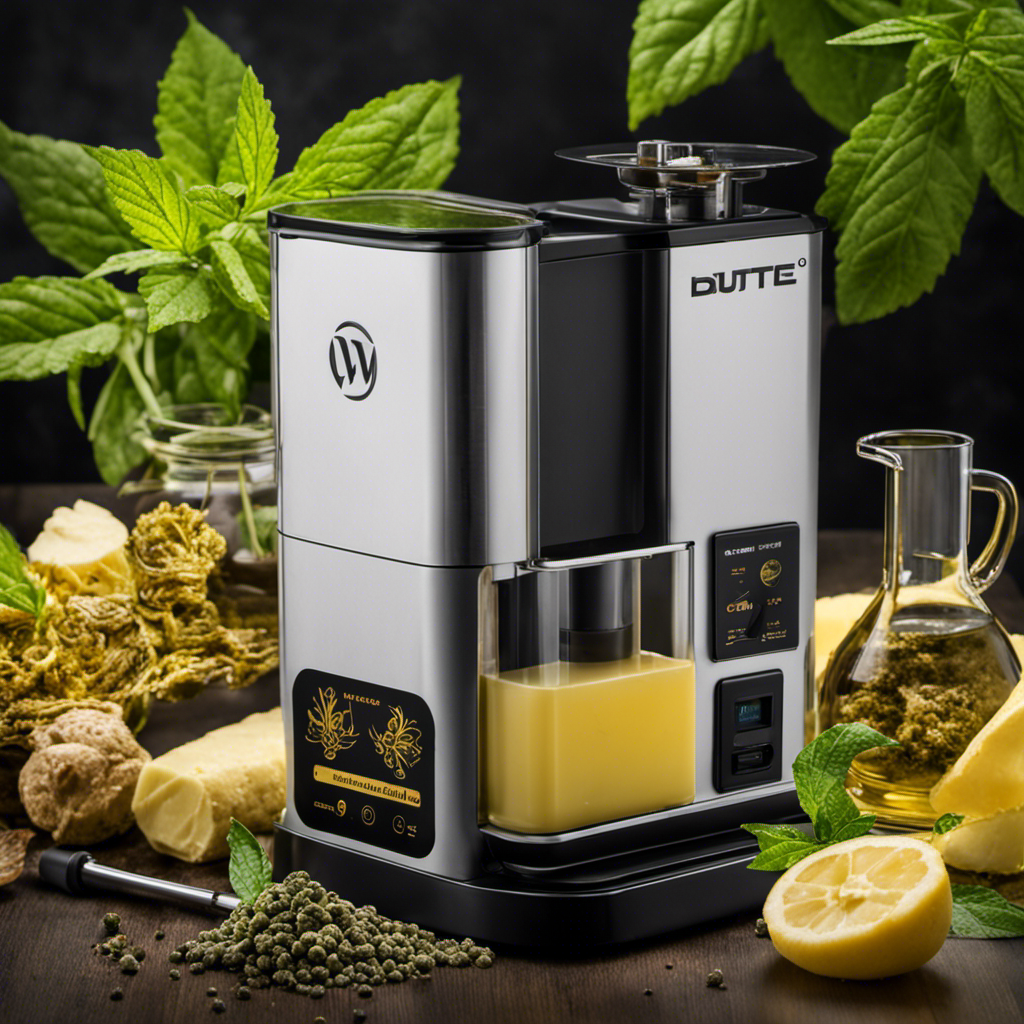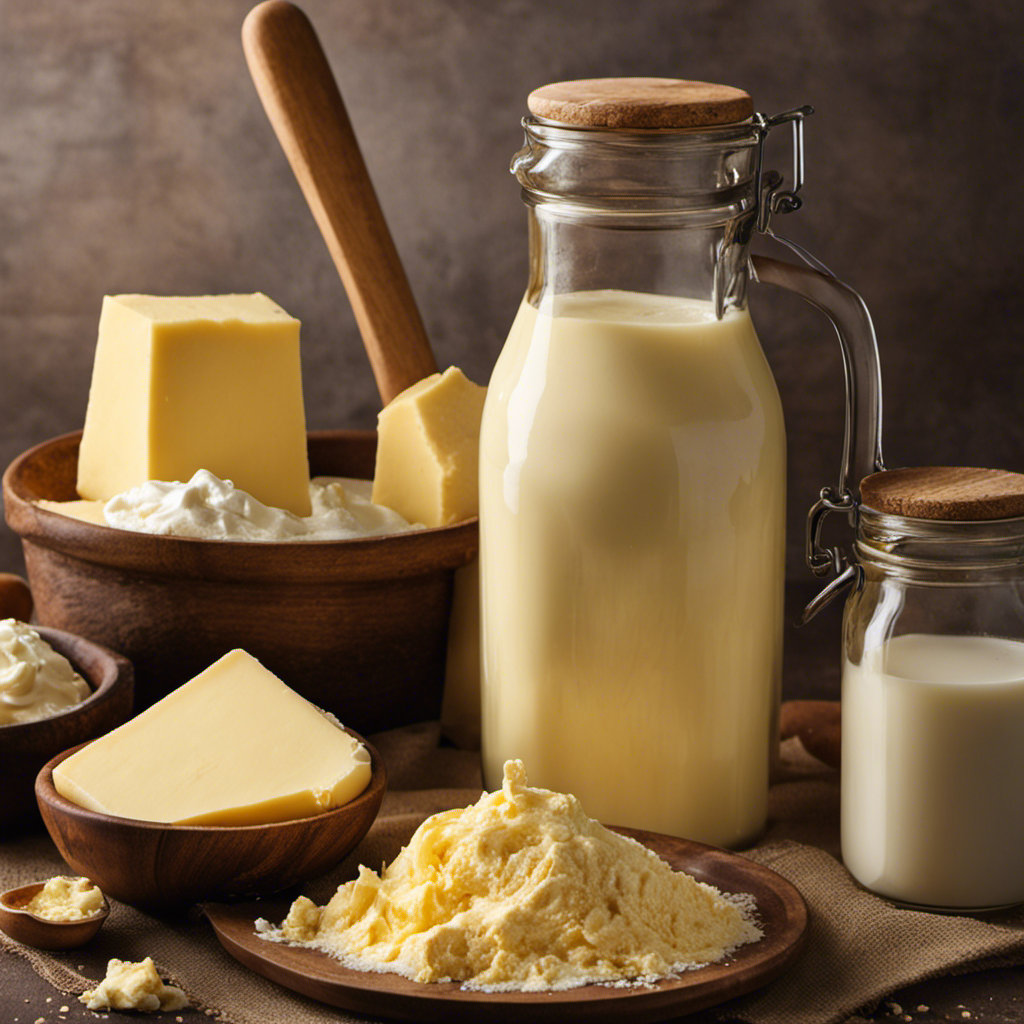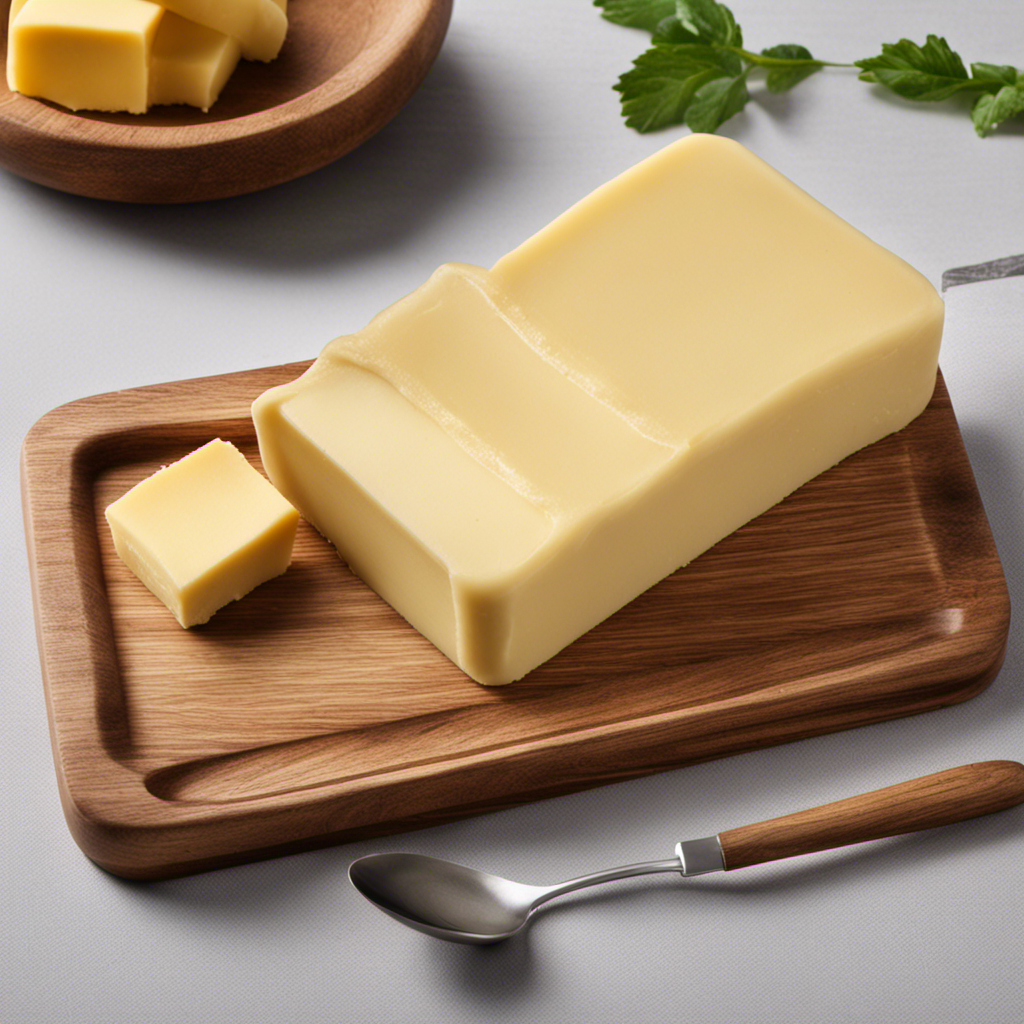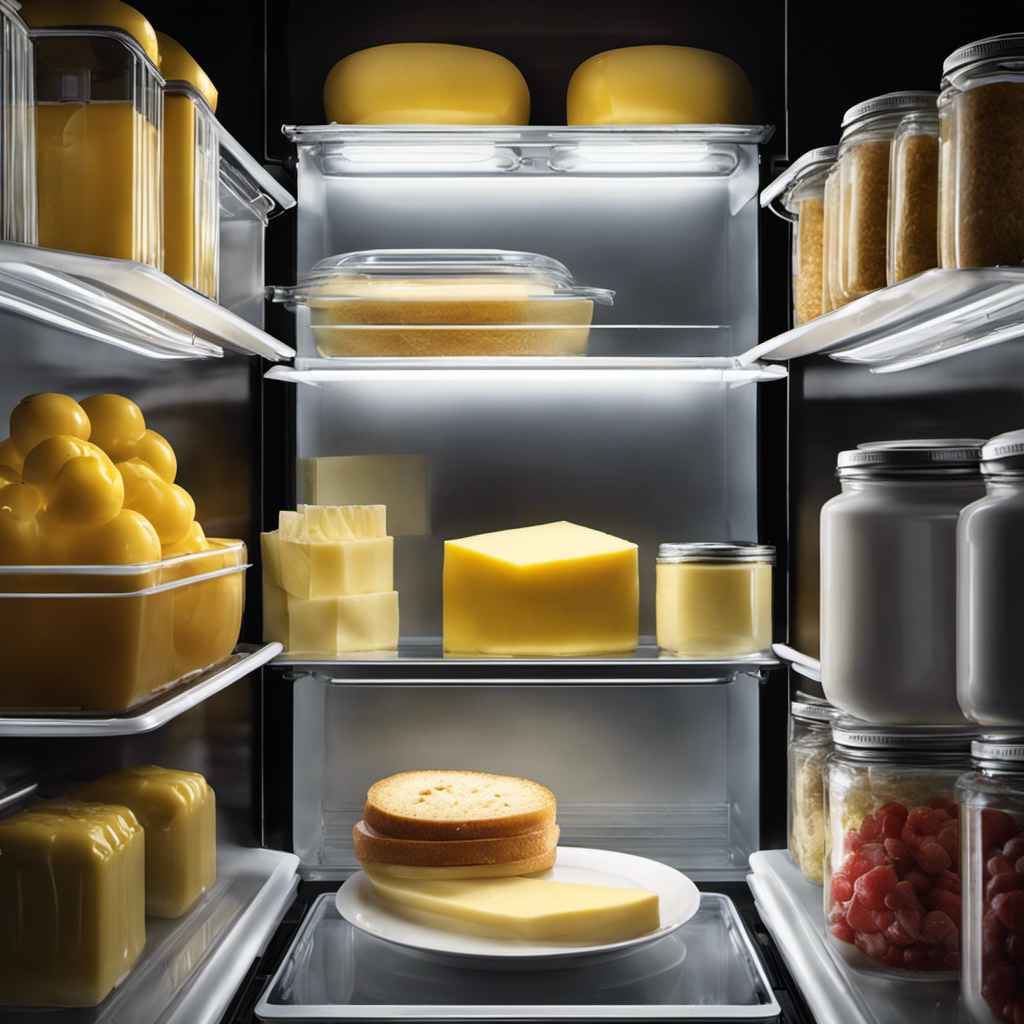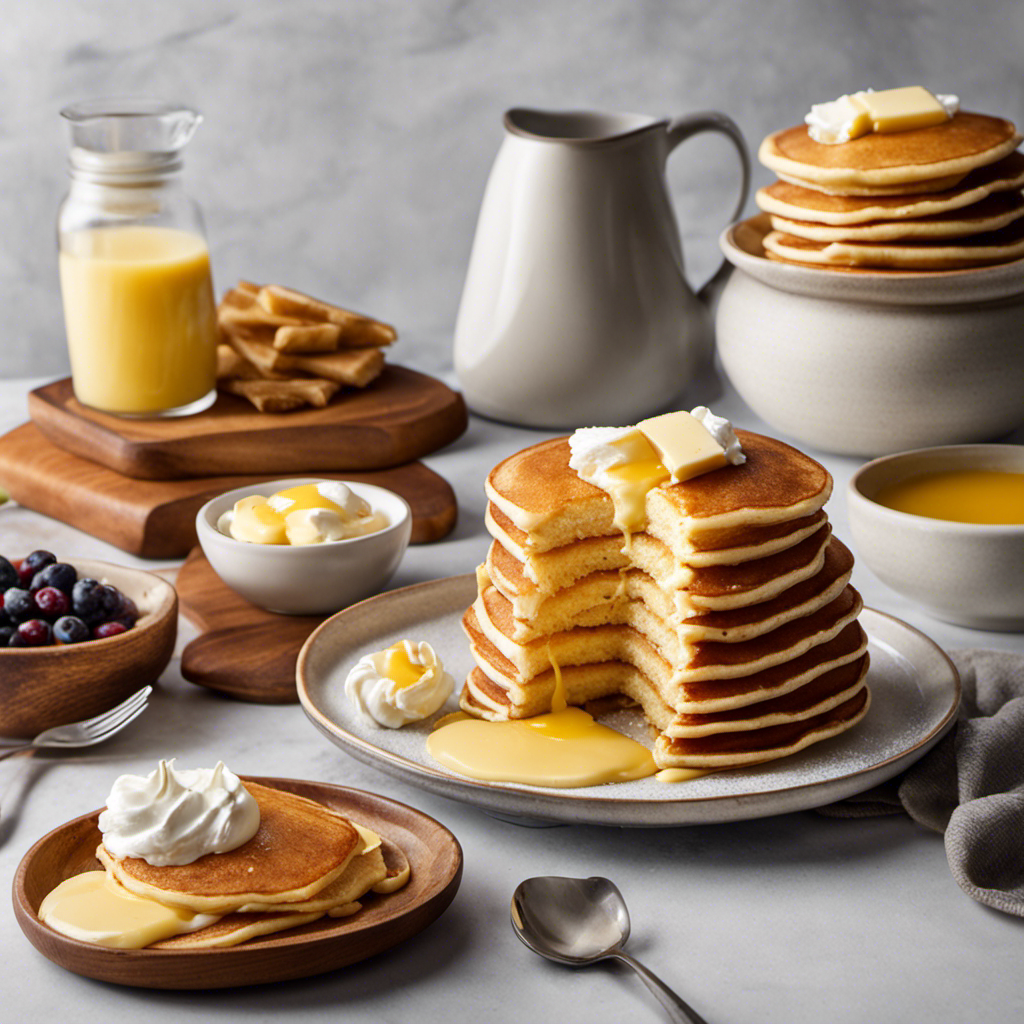I have found a revolutionary technique to create e-liquid for vaping out of buds by utilizing a butter maker.
Did you know that homemade vaping liquid can provide a more personalized and potent experience?
In this article, I’ll guide you through the process step by step, sharing my expertise on selecting the right butter maker, activating the cannabinoids in the buds, infusing butter with cannabis, and much more.
Get ready to elevate your vaping experience with this informative and precise guide.
Key Takeaways
- Choosing the right butter maker involves considering factors such as size, materials, and ease of use.
- Infusing butter with cannabis is a crucial step in making vaping liquid, and there are various methods for infusion.
- Decarboxylation is essential for activating cannabinoids in the buds and enhancing the potency of the vaping liquid.
- Proper grinding techniques and mixing infused butter with solvents like propylene glycol and vegetable glycerin are important for maximizing cannabinoid extraction.
Choosing the Right Butter Maker for Making Vaping Liquid
To choose the right butter maker for making vaping liquid, you’ll need to consider factors such as size, materials, and ease of use.
When it comes to butter maker options, there are a few key factors to keep in mind. Firstly, the size of the butter maker will determine how much vaping liquid you can produce at a time. If you plan on making large batches, you’ll want to opt for a larger butter maker.
Secondly, the materials used in the butter maker can affect the quality of the vaping liquid. Stainless steel butter makers are a popular choice as they are durable and easy to clean.
Lastly, ease of use is an important factor to consider. Look for a butter maker that has clear instructions and is user-friendly.
Now that we’ve covered the basics of choosing a butter maker, let’s discuss the best methods for infusion. One popular method is using the decarboxylation process to activate the cannabinoids in the buds before infusing them into the butter. This ensures a more potent vaping liquid.
Another effective method is using a slow cooker, as it allows for a controlled and consistent temperature during the infusion process.
Decarboxylation: Activating the Cannabinoids in the Buds
First, you’ll need to activate the cannabinoids in the buds through decarboxylation. This process involves heating the buds at a specific temperature to convert the non-psychoactive cannabinoids, such as THCA, into their active forms, like THC. Without decarboxylation, your vaping liquid won’t have the desired effects.
To successfully activate the cannabinoids, you’ll need to follow these steps:
- Preheat your oven to 240°F (115°C).
- Break up your buds into smaller pieces and spread them evenly on a baking sheet.
- Place the baking sheet in the preheated oven and bake for 45 minutes to an hour. This time and temperature combination will ensure proper decarboxylation without degrading the cannabinoids.
- Remove the baking sheet from the oven and let the buds cool completely.
- Once cooled, your buds are now ready for infusion into your vaping liquid.
Selecting High-Quality Cannabis Buds for Making Vaping Liquid
When selecting high-quality cannabis buds, it’s important to consider factors such as aroma, trichome density, and overall appearance. These characteristics can give you a good indication of the potency and quality of the strain.
Here are some key things to look for when choosing potent strains and understanding terpene profiles:
-
Aroma: A strong, pungent smell is often a sign of high-quality cannabis. Look for buds with a pleasant, distinct smell that is indicative of the strain’s terpene profile. Terpenes are the compounds responsible for the aroma and flavor of the plant.
-
Trichome Density: Trichomes are the tiny, crystal-like structures that cover the surface of the buds. They contain the majority of the plant’s cannabinoids, including THC and CBD. Look for buds with a dense coating of trichomes, as this indicates a higher concentration of cannabinoids.
-
Overall Appearance: High-quality buds should have vibrant colors, such as deep greens, purples, or oranges. Avoid buds that are dry, brittle, or have an excessive amount of stems or seeds.
-
Potency: Research the strain’s THC and CBD levels to determine its potency. Higher THC levels typically result in a more potent experience, while higher CBD levels may provide more medicinal benefits.
Grinding the Buds to the Optimal Consistency
Grinding the buds to the optimal consistency ensures a smooth vaping experience. When it comes to making vaping liquid from cannabis buds, the way you grind them plays a crucial role in maximizing cannabinoid extraction. Proper grinding techniques help to expose more surface area of the buds, allowing for better extraction of the desired compounds.
To achieve the optimal consistency, it is recommended to use a grinder specifically designed for cannabis. These grinders have sharp teeth that finely shred the buds without causing excessive damage. Avoid using scissors or your hands, as these methods can result in uneven grinding and loss of precious cannabinoids.
To help you understand the importance of grinding, here is a table showcasing the effects of different grinding techniques on cannabinoid extraction:
| Grinding Technique | Cannabinoid Extraction |
|---|---|
| Fine Grinding | High |
| Medium Grinding | Moderate |
| Coarse Grinding | Low |
| No Grinding | Negligible |
| Over-Grinding | Decreased |
As you can see, achieving the right consistency is crucial for maximizing cannabinoid extraction. Fine grinding allows for the most efficient extraction, while over-grinding can actually decrease the extraction efficiency.
Infusing Butter With Cannabis for Vaping Liquid
When it comes to creating vaping liquid from cannabis, the process of infusing butter plays a crucial role.
There are various methods for infusing butter with cannabis, each with its own advantages and considerations. Understanding these infusion methods is essential for achieving optimal potency and flavor in your vaping experience.
Additionally, exploring the different flavor options available for vaping allows you to personalize your cannabis consumption and enhance your overall enjoyment.
Butter Infusion Methods
To infuse butter with the buds, you’ll want to start by decarboxylating them in the oven. This process involves heating the cannabis at a low temperature to activate its psychoactive compounds. Once decarboxylated, you can proceed with the butter infusion techniques to create a potent vaping liquid.
Here are four methods to optimize infusion time:
-
Slow Cooker Method: Mix the decarboxylated buds with butter in a slow cooker, and let it cook on low heat for several hours. This method ensures a thorough infusion of cannabinoids into the butter.
-
Double Boiler Method: Place a heatproof bowl with butter and decarboxylated buds on top of a pot of simmering water. Stir occasionally for a couple of hours to infuse the butter evenly.
-
Sous Vide Method: Seal the decarboxylated buds and butter in a vacuum-sealed bag and immerse it in a water bath at a controlled temperature for a few hours. This precise method ensures maximum extraction of cannabinoids.
-
Mason Jar Method: Combine decarboxylated buds and butter in a mason jar, seal it tightly, and place it in a pot of simmering water. Let it infuse for a few hours, making sure to monitor the water level.
By using these techniques, you can optimize your infusion time and ensure a potent vaping liquid.
Now, let’s explore how to determine the potency of your final product.
Vaping Liquid Potency
In the previous subtopic, we discussed different butter infusion methods for making vaping liquid from buds. Now, let’s explore the potency of vaping liquid and its effects on lung health.
When it comes to vaping liquid dosage, it’s crucial to understand that the potency can vary depending on the concentration of THC or CBD in the liquid. To help you understand this better, here is a table showcasing different dosage levels and their potential effects:
| Dosage Level | Effects |
|---|---|
| Low | Mild relaxation and euphoria |
| Moderate | Increased relaxation and pain relief |
| High | Intense euphoria and potential impairment |
It’s important to note that vaping liquid, like any other form of cannabis consumption, may have an impact on lung health. While vaping is generally considered less harmful than smoking, it is not without risks. Some studies suggest that vaping can cause lung irritation and inflammation, although more research is needed to fully understand the long-term effects.
Now that we have a better understanding of vaping liquid potency and its potential effects on lung health, let’s move on to exploring the exciting world of flavor options for vaping.
Flavor Options for Vaping
Now that we’ve covered the potency and effects of vaping liquid, let’s explore the exciting world of flavor options available for vaping.
When it comes to vaping, the possibilities for flavors are virtually endless. Here are some popular options to consider:
-
Fruity flavors: From juicy watermelon to tangy citrus, fruity flavors can transport you to a tropical paradise with every puff.
-
Dessert flavors: Indulge your sweet tooth with flavors like creamy vanilla custard or rich chocolate brownie.
-
Minty flavors: Refresh your senses with cool and invigorating mint flavors that leave a refreshing aftertaste.
-
Terpene-infused flavors: Terpenes are aromatic compounds found in cannabis, and adding them to your vaping liquid can provide additional benefits such as relaxation or focus enhancement.
For those who enjoy a hands-on approach, DIY flavoring options are also available. By mixing different flavor concentrates, you can create your own unique blends and tailor your vaping experience to your preferences.
Understanding the importance of proper temperature control is crucial in order to maximize the flavor and enjoyment of your vaping experience.
Understanding the Importance of Proper Temperature Control
Make sure you’re closely monitoring the temperature while using the butter maker to ensure the proper extraction of cannabinoids from the buds.
Proper temperature control is crucial in achieving optimal extraction of cannabinoids for making vaping liquid. When the temperature is too low, the cannabinoids may not fully activate, resulting in a weaker and less potent vaping liquid. On the other hand, if the temperature is too high, it can cause the cannabinoids to degrade, leading to a loss of potency and flavor.
To achieve the proper temperature control, it is essential to follow the manufacturer’s instructions for your specific butter maker. Most butter makers have adjustable temperature settings, allowing you to set the desired temperature for extraction. It is recommended to start at a lower temperature, around 160-180°F (71-82°C), and gradually increase it if needed. This gradual increase helps to prevent overheating and ensures a more controlled extraction process.
Using a reliable thermometer is also highly recommended to accurately monitor the temperature. Insert the thermometer into the butter maker and keep a close eye on the temperature throughout the extraction process. Adjust the heat accordingly to maintain the desired temperature range.
Mixing the Infused Butter With Propylene Glycol and Vegetable Glycerin
To mix the infused butter with propylene glycol and vegetable glycerin, you’ll need to combine the two ingredients in a ratio that suits your desired potency and flavor. This step is crucial in creating a quality vaping liquid from your buds.
Here are some tips to help you get started:
-
Using alternative solvents: Instead of solely relying on butter as a solvent, incorporating propylene glycol and vegetable glycerin can enhance the vaping experience. These solvents have a lower boiling point, making them more suitable for vaping.
-
Experimenting with different ratios: Finding the right balance of propylene glycol, vegetable glycerin, and infused butter is essential. Start with a small batch and adjust the ratios until you achieve the desired potency and flavor. Keep in mind that a higher vegetable glycerin content will result in thicker vapor, while more propylene glycol will create a stronger throat hit.
-
Proper mixing technique: Ensure that all the ingredients are thoroughly mixed. You can use a magnetic stirrer or gently heat the mixture in a double boiler to aid in the blending process.
-
Testing and adjusting: After mixing, it’s important to test your vaping liquid. Take small puffs and consider adjusting the ratios if needed. Remember, experimentation is key to finding the perfect balance.
Calculating the Proper Ratios for the Vaping Liquid
Finding the perfect balance of propylene glycol, vegetable glycerin, and infused butter is crucial when calculating the proper ratios for your customized vaping liquid. The dosage of each ingredient plays a significant role in determining the overall quality and flavor of your vaping experience.
To calculate the correct dosage, you need to consider the potency of your infused butter and the desired strength of the vaping liquid. Start by determining the desired concentration of THC or CBD in your liquid, and then adjust the ratios accordingly.
If you prefer a stronger vaping liquid, you may increase the amount of infused butter, while reducing the proportion of propylene glycol and vegetable glycerin. On the other hand, if you want a milder flavor, you can decrease the dosage of infused butter and increase the ratio of propylene glycol and vegetable glycerin. This will help you achieve the perfect balance between potency and flavor.
Once you have calculated the correct dosage, you can move on to adjusting the flavor profile by adding additional flavorings or extracts. By experimenting with different combinations, you can create a vaping liquid that suits your personal preferences.
Now that you have calculated the proper ratios for your vaping liquid, let’s move on to using a double boiler method to combine the ingredients.
Using a Double Boiler Method to Combine the Ingredients
Using a double boiler method, you’ll effortlessly combine the propylene glycol, vegetable glycerin, and infused butter to create your vaping liquid. This method ensures a gradual and controlled heating process, preventing any overheating or burning of the ingredients. It also helps to maintain the potency of the infused butter, ensuring that you get the most out of your buds.
To make the vaping liquid using a double boiler, follow these simple steps:
- Fill the bottom pot of the double boiler with water and place it on the stove over low heat.
- Place the top pot of the double boiler on top of the bottom pot.
- Add the propylene glycol, vegetable glycerin, and infused butter to the top pot.
- Stir the mixture gently until everything is well combined and the butter has melted completely.
By using this method, you can have full control over the heating process, allowing for a smoother and more consistent vaping experience. However, if you prefer a quicker method, you can also use a microwave to combine the ingredients. Just be sure to use a microwave-safe container and heat the mixture in short intervals, stirring in between to ensure even heating.
Additionally, don’t be afraid to experiment with different strains of cannabis when making your vaping liquid. Each strain has its own unique flavor profile, and by trying out different combinations, you can create a truly customized and enjoyable vaping experience. So go ahead and explore the world of flavors that cannabis has to offer!
Straining the Mixture to Remove Plant Matter and Impurities
When it comes to straining the mixture to remove plant matter and impurities, efficient techniques are essential for achieving a high-quality vaping liquid.
By utilizing proper straining methods, such as using fine mesh filters or cheesecloth, one can effectively separate the desired liquid from any unwanted particles.
This not only ensures a smoother vaping experience but also enhances the overall quality of the liquid by filtering out impurities that could potentially affect its taste or texture.
Efficient Straining Techniques
To achieve maximum efficiency when straining, it’s important to use a fine mesh strainer or cheesecloth. These tools help remove unwanted plant matter and impurities from your vaping liquid, ensuring a smoother and cleaner experience.
Here are some techniques that can improve efficiency and reduce waste during the straining process:
-
Use a fine mesh strainer or cheesecloth: These tools have smaller holes, allowing for better filtration and finer results.
-
Press the mixture gently: Applying too much force can push through unwanted particles, affecting the quality of the final product.
-
Strain in batches: Instead of straining the entire mixture at once, strain small amounts at a time to ensure thorough filtration.
-
Clean and reuse your strainer or cheesecloth: By rinsing and drying them properly, you can extend their lifespan and reduce waste.
Filtering Out Impurities
It’s important to ensure that the strainer or cheesecloth has been properly cleaned and dried in order to remove any impurities from the filtration process.
Improving filtration techniques is essential to ensure the purity and quality of the liquid. While traditional methods like using a strainer or cheesecloth are effective, there are alternative purification methods that can be employed to enhance the filtration process.
One such method is activated charcoal filtration, which helps remove toxins and impurities from the liquid. Another option is using a coffee filter, which can provide a finer filtration and remove even smaller particles.
These alternative methods can help improve the overall quality of the liquid and ensure a clean and enjoyable vaping experience. By incorporating these techniques, you can enhance the liquid’s quality and make it even more satisfying to vape.
Enhancing Liquid’s Quality
Using activated charcoal filtration or a coffee filter can improve the quality of the liquid by removing impurities and toxins. This step is crucial in ensuring a clean and safe vaping experience.
Filtration doesn’t just stop at removing impurities; it also plays a role in enhancing the taste and effectiveness of the liquid. Here are some ways filtration can improve your vaping liquid:
- Removing unwanted particles and debris
- Enhancing the clarity of the liquid
- Increasing the smoothness of the vapor
- Improving the overall flavor profile
Achieving the Desired Flavors With Terpenes or Flavorings
You can enhance the flavors of your vaping liquid by adding terpenes or flavorings to achieve the desired taste. Terpenes are organic compounds found in plants that give them their unique aroma and flavor. They can be extracted from various sources using different methods such as steam distillation, solvent extraction, or cold pressing. Each method has its pros and cons, so it’s important to do your research and choose the one that suits your needs best.
If you prefer a more DIY approach, there are also flavoring techniques that you can try. For example, you can infuse your vaping liquid with fruits, herbs, or spices to create your own custom flavors. Simply steep the desired ingredient in your liquid for a certain period of time to allow the flavors to infuse. Remember to strain the liquid before using it to remove any solid particles.
In the next section, we’ll explore storing and aging the vaping liquid for enhanced flavor. By properly storing your liquid in a cool, dark place, you can allow the flavors to meld together and develop over time. This aging process can result in a smoother and more complex flavor profile. So, let’s dive into the art of storing and aging your vaping liquid to unlock even more delicious flavors.
Storing and Aging the Vaping Liquid for Enhanced Flavor
By properly storing and aging your vaping liquid, the flavors will meld together and develop over time, resulting in a smoother and more complex flavor profile. Aging techniques play a crucial role in flavor infusion, allowing the different components of the liquid to blend harmoniously.
Here are some tips to ensure optimal flavor development:
- Keep your vaping liquid in a cool, dark place to protect it from heat and light, which can degrade the flavors.
- Store the liquid in glass bottles to prevent any potential interactions with plastic containers.
- Shake the bottles regularly to promote the mixing of flavors and prevent any separation.
- Give the liquid enough time to age, as certain flavors may take longer to develop than others.
Properly aging your vaping liquid can greatly enhance the overall vaping experience by intensifying and refining the flavors. The aging process allows the flavors to meld together, resulting in a more harmonious and enjoyable taste.
However, before enjoying the flavors, it is important to test the potency and quality of the vaping liquid.
Testing the Potency and Quality of the Vaping Liquid
After storing and aging the vaping liquid for enhanced flavor, it’s important to test its potency and quality. Testing the vaping liquid ensures that it meets your desired standards and provides a consistent vaping experience. There are several testing methods you can use to analyze the results.
One common testing method is to use a portable vaporizer or vape pen to vaporize a small amount of the liquid. By inhaling the vapor and paying attention to its taste, aroma, and effects, you can assess its potency and overall quality. Additionally, you can send a sample of the liquid to a lab for more precise testing, such as cannabinoid profiling or residual solvent analysis.
Once you have the test results, it’s crucial to analyze them carefully. Look for any discrepancies or unexpected findings that may indicate issues with the vaping liquid. For example, if the potency is significantly lower than expected, it may suggest that the decarboxylation process was not sufficient, or the extraction method needs improvement.
Filling and Refilling Vape Cartridges With the Homemade Liquid
Once the homemade liquid has been tested for potency and quality, it’s time to fill and refill vape cartridges. This step is crucial to ensure a smooth vaping experience and prevent any leaks or spills. Here are some techniques to help you refill your cartridges like a pro:
-
Choose the right cartridge: Select a cartridge that is compatible with your vape pen and can hold the desired amount of liquid. Different cartridges have different capacities, so make sure to check the specifications.
-
Start with a clean cartridge: Before refilling, clean the cartridge thoroughly to remove any residue or leftover liquid. This will prevent any unwanted flavors mixing with your homemade liquid.
-
Fill the cartridge carefully: Use a syringe or dropper to fill the cartridge slowly and avoid overfilling. This will prevent leaks and ensure that the liquid is evenly distributed.
-
Secure the cartridge tightly: After refilling, make sure to screw the cartridge tightly onto the vape pen. A loose cartridge can lead to leaks and a messy vaping experience.
By following these refilling techniques and taking the necessary precautions, you can enjoy a hassle-free vaping experience and prevent any leaks or spills.
Happy vaping!
Troubleshooting Common Issues and Improving the Vaping Experience
When it comes to vaping, two key factors that can greatly impact the overall experience are flavor profiles and vapor production.
Enhancing flavor profiles involves finding the right balance of ingredients and techniques to create a more enjoyable and satisfying taste.
On the other hand, resolving vapor production issues requires troubleshooting and adjusting various elements, such as airflow and coil resistance, to ensure a consistent and satisfying amount of vapor is produced.
Enhancing Flavor Profiles
To enhance the flavor profiles of your vaping liquid, you’ll want to experiment with different strains of buds and various flavor additives. Here are some tips to help you enhance your vaping experience:
-
Try different strains of buds: Each strain has its own unique flavor profile, so experimenting with different strains can help you find the perfect flavor combination for your vaping liquid.
-
Mix flavors: Don’t be afraid to mix different flavors together to create your own unique blend. For example, you could mix fruity flavors with creamy flavors to create a delicious and satisfying vape.
-
Add flavor additives: Flavor additives like menthol or vanilla can enhance the taste of your vaping liquid. Start with a few drops and adjust according to your preference.
-
Experiment with ratios: Changing the ratio of buds to flavor additives can also affect the flavor profile of your vaping liquid. Play around with different ratios until you find the perfect balance.
By experimenting with different flavor combinations, you can create a vaping liquid that suits your taste preferences.
Now, let’s move on to resolving vapor production.
Resolving Vapor Production
If you’re experiencing low vapor production, adjusting your device’s wattage settings could help improve the amount of vapor you’re getting. Increasing the wattage can provide more power to the coil, resulting in higher temperatures and increased vapor production. However, it’s important to find the right balance, as setting the wattage too high can lead to a burnt taste or even damage the coil. To troubleshoot vapor issues, refer to the table below for general wattage recommendations based on the resistance of your coil:
| Coil Resistance | Recommended Wattage |
|---|---|
| 0.1 – 0.2 ohms | 80 – 120 watts |
| 0.3 – 0.4 ohms | 40 – 60 watts |
| 0.5 – 0.6 ohms | 30 – 40 watts |
| 1.0 – 1.2 ohms | 10 – 16 watts |
Frequently Asked Questions
Can I Use Any Type of Butter Maker for Making Vaping Liquid?
Yes, you can use any type of butter maker for making vaping liquid. Different methods for making vaping liquid with a butter maker exist, and using a butter maker offers benefits such as efficiency and convenience.
How Do I Know if the Cannabinoids in the Buds Have Been Properly Activated During Decarboxylation?
To ensure accurate cannabinoid activation during decarboxylation, it is crucial to monitor the temperature and time. This process converts inactive cannabinoids into their active form, enhancing the potency and effects of the vaping liquid.
What Characteristics Should I Look for in High-Quality Cannabis Buds for Making Vaping Liquid?
When it comes to making vaping liquid, the characteristics of high-quality cannabis buds are crucial. Look for dense, sticky buds with a strong aroma and vibrant colors. These indicators signal the potential for a potent and flavorful vaping experience.
How Fine Should I Grind the Buds for Optimal Consistency in the Vaping Liquid?
When it comes to grinding buds for vaping liquid, achieving optimal consistency is key. You want to ensure that the buds are finely ground to maximize surface area and aid in the decarboxylation process.
Can I Use Any Type of Flavorings or Terpenes to Achieve the Desired Flavors in the Vaping Liquid?
Yes, you can use various flavorings or terpenes to achieve desired flavors in the vaping liquid. However, it is important to ensure the safety of these additives and consider any potential health concerns they may pose.
Conclusion
In conclusion, making vaping liquid from buds with a butter maker is a rewarding and enjoyable process. By choosing the right butter maker and selecting high-quality cannabis buds, you can ensure a potent and flavorful vaping experience.
Through proper decarboxylation and grinding techniques, you can activate the cannabinoids and achieve the optimal consistency. Infusing butter with cannabis and aging the liquid will enhance its flavor.
By testing the potency and quality, and troubleshooting any issues, you can improve your vaping experience. So, grab your butter maker and enjoy the satisfaction of creating your own homemade vaping liquid.
